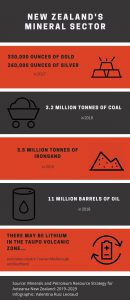The New Zealand government recently issued its 2019-2029 Minerals and Petroleum Resource Strategy, which highlights the importance of the mining and oil sectors to the country’s goal of transitioning into a low-emissions economy.
According to the document, the island-nation could soon start exploring opportunities to meet its domestic and
“As the energy system transforms, we also need to make sure we have the minerals (such as rare earth elements) necessary to produce the technology we need to power our future. To meet these challenges, the minerals and petroleum sector needs to plan now, in order to build a more productive, sustainable, and inclusive economy.”
Besides battery metals and REE, the proposal acknowledges the need for fossil fuels and base metals. “We need to make sure we have the aggregate (crushed rock and stone) required, or alternative replacement material, to build the foundations of our houses and roads. We need coal to make the steel necessary to build our cities, but we should start to investigate alternative methods of steel production which reduce environmental impacts.”

The document emphasizes the importance of protecting the environment and properly consulting communities surrounding mining projects and Indigenous communities whose heritage could be affected by extractive activities.
In this regard, the strategy provides a number of principles that should guide mining operations. Namely, it asks miners to pursue continuous improvements in health and safety and to seek innovative ways to improve the resource efficiency of extraction operations, while minimizing their negative impacts.
Where impacts cannot be avoided, industry is being asked to engage with stakeholders and implement management systems to understand and manage the negative effects of their operations, while realizing opportunities for redress.
The Kiwi government says it plans to achieve those grand objectives by modernizing the Crown Minerals Act; securing affordable resources to meet the country’s mineral and energy needs; improving Treaty Partnerships and stakeholder and community engagement; improving industry compliance; and promoting research and investment in better mining and resource use.
Industry cautious
In response to the strategy, Straterra, New Zealand’s minerals sector industry organization, issued a communiqué saying its members “cautiously welcomed” the document.
Even though the group applauds that the strategy recognizes the importance of minerals to society and shows a willingness to work with the sector, it laments the fact that it stays the executive’s support to the No New Mines on Conservation Land policy. This proposed regulation was announced in 2017 soon after Prime Minister Jacinda Ardern took power but it still hasn’t come into effect.
“The resource sector faces a number of reforms, the objective of which is to improve environmental outcomes. The reality is that many aspects of these reforms will simply result in reduced or zero investment,” Straterra’s CEO, Chris Baker, said in the statement. “We hope that this Resource Strategy goes some way to influencing the balance that is required in these reforms, to get better environmental outcomes and to attract more responsible investment.”






